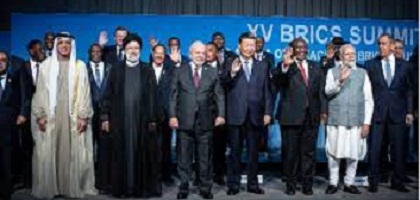By Henok Tadele Haile – The grandeur of ancient civilizations conjures images of vast empires, mighty monuments, and cross-continental trade routes. While the glories of these bygone eras faded with the onset of modernity, the ancient powers are converging again in the form of the BRICS alliance.
The South-South cooperation BRICS alliance brings together major emerging economies – Brazil, Russia, India, China, and South Africa. With the recent addition of six nations – Argentina, Egypt, Ethiopia, Iran, Saudi Arabia, and the United Arab Emirates (UAE) – the bloc now encompasses at least eight celebrated ancient civilizations. This convergence sets the stage for these modern giants to leverage their economic might and reclaim the global influence of their storied pasts.
Out of the BRICS members, China, India, Russia, Egypt, Ethiopia, Saudi Arabia, the UAE, and Iran share at least millennia-old histories as dominant powers in their regions. They were the center of trade and culture for centuries, leaving enduring legacies in philosophy, science, architecture, and more.
But the ascent of Europe during the Industrial Revolution disrupted their prominence. As innovation shifted westward, these ancient societies saw their glory fade.
Today, the tide turns again. With projected growth in coming decades, China may overtake the United States as the world’s biggest economy by 2028. India is predicted to become the third largest by 2050. This formidable collective economic strength will amplify the voice of the Global South in international institutions.
The growth projections for the BRICS economies over the next decades foreshadow a shifting world order where the Global South asserts itself. China is predicted to overtake the United States as the biggest economy by 2028, while India moves into third place by 2050. With the current expansion, together, the BRICS countries encompass over 46 % of the world’s population and over a third of economic output, as Brazilian President Lula de Silva said, while speaking about the addition of the six new members.
Harnessing this collective economic strength could allow the BRICS nations to drive development, lift billions out of poverty and reconfigure institutions like the United Nations Security Council. More importantly they will be expected to devise a way to depolarize the world economy as the dependence in the greenback sow its weaponization by the collective west.
Beyond material gains, the BRICS alliance enables renewed exchange between once interconnected cultures. Like the fabled Silk Road, these modern powers can create new networks of cooperation and commerce. Integrating their shared wisdom and heritage into these partnerships would further enrich the bloc.
But reclaiming their rightful place on the global stage also comes with challenges. Can these ancient civilizations reconcile their historic rivalries and competing interests? Their differing political systems and ideologies adds further complexity, too.
Nonetheless, the vast potential of this alliance is clear. As these awakened giants build new mechanisms for finance and policymaking, they could pioneer a multi-polar world order centered on equity and sustainability. By pooling their rich histories and modern capabilities, the BRICS countries and their new partners can shape a future that honors both the legacy of the past and the promise of progress.
Though the BRICS alliance brings immense potential, lingering divisions threaten to undermine the bloc’s unity. As these awakened giants seek to shape the global order, the West also watches wary of rising challengers. Western powers could exploit rifts between BRICS members to maintain dominance.
Several fault lines fracture BRICS unity. The two giants, India and China, grapple over long-standing border disputes that periodically flare into conflict. Regional rivals Iran and Saudi Arabia support opposing sides in power struggles like the Syrian civil war. Upstream Ethiopia remains at odds with Egypt over Nile river usage. Even Gulf allies UAE and Saudi Arabia vie for influence in the Middle East.
Beyond border conflicts, differing political systems and ideologies sow discord. India champions democracy while China touts authoritarian capitalism. Theocracy rules in Iran and Saudi Arabia. These competing models of governance complicate building consensus within the bloc.
If the BRICS coalition seeks to fulfill its potential, these ancient civilizations must strengthen trust and cooperation. They can learn from the West’s playbook of sublimating internal conflicts to counter external threats. While differences persist, emphasizing shared interests in issues like climate change, counterterrorism, and economic growth can help unite the bloc.
Bridging divides requires compromise. The BRICS nations must become adept at multivariate diplomacy, bilaterally engaging partners while maintaining cohesion. Success depends on their ability to align their historical pride with modern pragmatism. If these awakened giants can collectively overcome their rivalries, they can avoid divides that outside powers can exploit and instead focus on shaping the world order side-by-side.

